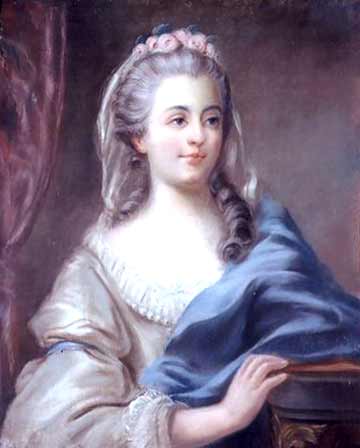|
Saint-Fal
Saint-Fal, real name Étienne Meynier (or Saint Phal) (10 June 1752 – 22 November 1835) was a French stage actor. Biography Étienne Meynier was born in Paris, France on 10 June 1752. After he participated in an amateur troupe, he integrated that of Mademoiselle Montansier at Versailles, then moved to The Hague where he stayed three years. He performed in Lyon in 1781, then at the Théâtre de la Monnaie in Brussels. On 8 July 1782, Saint-Fal made his debut at the Comédie-Française in ''Gaston et Bayard'' by Belloy. Received as a test on 17 March 1783, he was definitely admitted on 25 March of the following year. At the time of the French Revolution, Saint-Fal was denounced by La Bussière and thrown into jail. On his release, he joined Mlle Raucourt at the Théâtre Louvois and then gave the exact measure of his talent. On the night of 2 September 1793, he was arrested again, along with 12 other comedians in the Théâtre Français remained loyal to the monarchy, a ... [...More Info...] [...Related Items...] OR: [Wikipedia] [Google] [Baidu] |
Madelonnettes Convent
The Madelonnettes Convent (''couvent des Madelonnettes'') was a Paris convent in the 3rd arrondissement of Paris. It was located in what is now a rectangle between 6 rue des Fontaines du Temple (where there are the remains of one of its walls), rue Volta and rue du Vertbois, and part of its site is now occupied by the Lycée Turgot. As the Madelonnettes Prison (''prison des Madelonnettes'') during the French Revolution, its prisoners included the writers the Marquis de Sade and Nicolas Chamfort, the politician Jean-Baptiste de Machault d'Arnouville and the actor Dazincourt. Convent Origins Its origins date back to 1618, when the wine merchant Robert de Montry - after being rebuffed by the local prostitutes in his attempts to reform them - finally decided to put them back to the right path whilst being accommodated in his own home. With the aid of M. Du Pont (curé of Saint-Nicolas des Champs), the Capuchin Father Athanase Molé and M. de Fresne (an officer of the Gardes du Co ... [...More Info...] [...Related Items...] OR: [Wikipedia] [Google] [Baidu] |
Paris
Paris () is the capital and most populous city of France, with an estimated population of 2,165,423 residents in 2019 in an area of more than 105 km² (41 sq mi), making it the 30th most densely populated city in the world in 2020. Since the 17th century, Paris has been one of the world's major centres of finance, diplomacy, commerce, fashion, gastronomy, and science. For its leading role in the arts and sciences, as well as its very early system of street lighting, in the 19th century it became known as "the City of Light". Like London, prior to the Second World War, it was also sometimes called the capital of the world. The City of Paris is the centre of the Île-de-France region, or Paris Region, with an estimated population of 12,262,544 in 2019, or about 19% of the population of France, making the region France's primate city. The Paris Region had a GDP of €739 billion ($743 billion) in 2019, which is the highest in Europe. According to the Economist Intelli ... [...More Info...] [...Related Items...] OR: [Wikipedia] [Google] [Baidu] |
Dazincourt
Joseph-Jean-Baptiste Albouy (11 December 1747, in Marseille – 28 March 1809, in Paris), stage name Dazincourt, was a French actor. Life Educated by the Oratorians, Dazincourt entered the service of the maréchal de Richelieu in 1766 and had a taste of acting in comedies of manners. Deciding to make this his profession, he left Paris in secret for Brussels to study under D'Hannetaire, then at the peak of his reputation. After acting at the Théâtre de la Monnaie from 1771 to 1776, Dazincourt returned to Paris and made his debut at the Comédie-Française on 21 November 1776 in the rôle of Crispin in ''Les Folies amoureuses'' by Jean-François Regnard. He became a sociétaire of this theatre in 1778 and remained one until his death. In December 1776 the ''Mercure de France'' commented on his debuts: "This actor has a well-formed talent, a reasoned manner, and much intelligence, finesse and truth-to-life. He is a good comic-actor without being a farceur, and pleasing with ... [...More Info...] [...Related Items...] OR: [Wikipedia] [Google] [Baidu] |
Louise Contat
Louise-Françoise Contat (16 June 1760 – 9 March 1813) was a French actress. Biography She was born in Paris and made her debut at the Comédie Française in 1766 as Atalide in '' Bajazet''. It was in comedy, however, that she made her first success, as Suzanne in Beaumarchais's '' Mariage de Figaro''; and in several minor character parts, which she raised to the first importance, and as the ''soubrette'' in the plays of Molière and Pierre de Marivaux, she found opportunities exactly fitted to her talents. By Louis Marie Jacques Amalric, comte de Narbonne-Lara (17, 23 or 24 August 1755 – 17 November 1813), soldier and diplomat, she had one daughter Louise Amalrique Bathilde Isidore Contat de Narbonne-Lara, born at Saint Pierre de Chaillot, Paris, on 21 September 1788, who married in Paris on 2 December 1811 Dutch Jan Frederik Abbema, born in Amsterdam on 13 June 1773, and had one son Émile, vicomte d' Abbéma, who had an only daughter by his wife Henriette Anne d'Asto ... [...More Info...] [...Related Items...] OR: [Wikipedia] [Google] [Baidu] |
Sainte-Pélagie Prison
Sainte-Pélagie was a prison in Paris, in active use from 1790 to 1899. It was founded earlier than that, however, in 1662, as place for "repentant girls" and later "debauched women and girls." The former Parisian prison was located between the current group of buildings bearing No. 56 Rue de la Clef with Rue du Puits-de-l'Ermite in the 5th arrondissement of Paris at the old Place Sainte-Pélagie. The penal structure held many noted prisoners during the French Revolution, with Madame Roland, Grace Dalrymple Elliott and Marie-Louise O'Murphy being among the known prisoners. After the revolution, the Marquis de Sade was imprisoned here, as was the young mathematician Évariste Galois. During the July Monarchy, the "April insurgees" were also detained there, and some managed to escape through a tunnel. The painter Gustave Courbet was also imprisoned here for his activities in the Paris Commune. He painted a self-portrait titled, '' Gustave Courbet: Self-Portrait at Sainte-Pélagie' ... [...More Info...] [...Related Items...] OR: [Wikipedia] [Google] [Baidu] |
Ministerial Order
A ministerial decree or ministerial order is a decree by a ministry. With a ministerial decree the administrative department is delegated the task to impose a formal judgement or mandate. Ministerial decrees are usually imposed under the authority of the department's chief minister, secretary or administrator. Belgium In Belgium, a ministerial decree ( nl, ministerieel besluit, french: arrêté ministériel) is a decision of a minister of the federal government. The Belgian Constitution stipulates that the King of Belgium, in practice the federal government as a whole, is responsible for the execution of laws adopted by the federal parliament. This is done by royal order. For more detailed measures, the minister responsible can act alone by ministerial order. Ministerial orders must be published in the Belgian Official Journal before they can enter into force. Canada In Canada, a ministerial order (french: arrêté ministériel) is a decision made by a Minister of the Crown, ... [...More Info...] [...Related Items...] OR: [Wikipedia] [Google] [Baidu] |
Committee Of Public Safety
The Committee of Public Safety (french: link=no, Comité de salut public) was a committee of the National Convention which formed the provisional government and war cabinet during the Reign of Terror, a violent phase of the French Revolution. Supplementing the Committee of General Defence created after the execution of King Louis XVI in January 1793, the Committee of Public Safety was created in April 1793 by the National Convention. It was charged with protecting the new republic against its foreign and domestic enemies, fighting the First Coalition and the Vendée revolt. As a wartime measure, the committee was given broad supervisory and administrative powers over the armed forces, judiciary and legislature, as well as the executive bodies and ministers of the Convention. As the committee, restructured in July, raised the defense ('' levée en masse'') against the monarchist coalition of European nations and counter-revolutionary forces within France, it became more and more ... [...More Info...] [...Related Items...] OR: [Wikipedia] [Google] [Baidu] |
Carlo Goldoni
Carlo is a given name. It is an Italian form of Charles. It can refer to: *Carlo (name) *Monte Carlo *Carlingford, New South Wales, a suburb in north-west Sydney, New South Wales, Australia *A satirical song written by Dafydd Iwan about Prince Charles. *A former member of Dion and the Belmonts best known for his 1964 song, Ring A Ling. *Carlo (submachine gun), an improvised West Bank gun. * Carlo, a fictional character from Animal Crossing: Pocket Camp * It can be confused with Carlos * Carlo means “man” (from Germanic “karal”), “free man” (from Middle Low German “kerle”) and “warrior”, “army” (from Germanic “hari”). See also *Carl (name) *Carle (other) *Carlos (given name) Carlos is a masculine given name, and is the Portuguese and Spanish variant of the English name ''Charles'', from the Germanic ''Carl''. Notable people with the name include: Royalty *Carlos I of Portugal (1863–1908), second to last King of P ... {{disambig Italian ... [...More Info...] [...Related Items...] OR: [Wikipedia] [Google] [Baidu] |
Samuel Richardson
Samuel Richardson (baptised 19 August 1689 – 4 July 1761) was an English writer and printer known for three epistolary novels: ''Pamela; or, Virtue Rewarded'' (1740), '' Clarissa: Or the History of a Young Lady'' (1748) and ''The History of Sir Charles Grandison'' (1753). He printed almost 500 works, including journals and magazines, working periodically with the London bookseller Andrew Millar. Richardson had been apprenticed to a printer, whose daughter he eventually married. He lost her along with their six children, but remarried and had six more children, of which four daughters reached adulthood, leaving no male heirs to continue the print shop. As it ran down, he wrote his first novel at the age of 51 and joined the admired writers of his day. Leading acquaintances included Samuel Johnson and Sarah Fielding, the physician and Behmenist George Cheyne, and the theologian and writer William Law, whose books he printed. At Law's request, Richardson printed some poems by J ... [...More Info...] [...Related Items...] OR: [Wikipedia] [Google] [Baidu] |
Comedy
Comedy is a genre of fiction that consists of discourses or works intended to be humorous or amusing by inducing laughter, especially in theatre, film, stand-up comedy, television, radio, books, or any other entertainment medium. The term originated in ancient Greece: in Athenian democracy, the public opinion of voters was influenced by political satire performed by comic poets in theaters. The theatrical genre of Greek comedy can be described as a dramatic performance pitting two groups, ages, genders, or societies against each other in an amusing '' agon'' or conflict. Northrop Frye depicted these two opposing sides as a "Society of Youth" and a "Society of the Old". A revised view characterizes the essential agon of comedy as a struggle between a relatively powerless youth and the societal conventions posing obstacles to his hopes. In this struggle, the youth then becomes constrained by his lack of social authority, and is left with little choice but to resort to ruses w ... [...More Info...] [...Related Items...] OR: [Wikipedia] [Google] [Baidu] |





.jpg)
